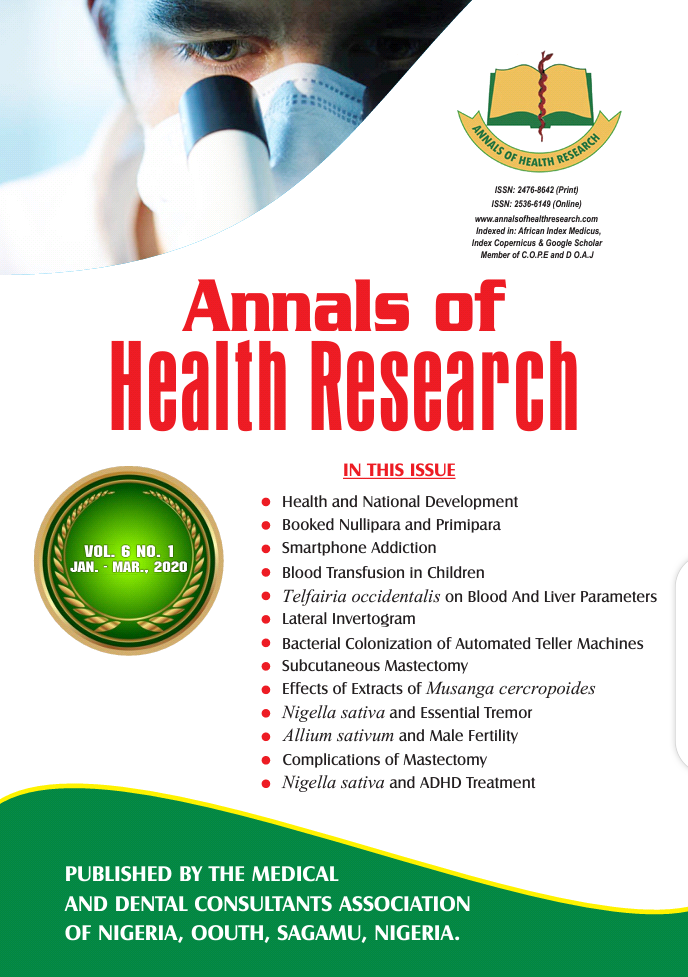Indications for blood and blood products transfusions among children in a semi-urban tertiary hospital in Nigeria
DOI:
https://doi.org/10.30442/ahr.0601-04-64Keywords:
Blood, Blood Transfusion, Plasma, Red Blood Cells, TransfusionAbstract
Background: Anaemia is prevalent among children in our environment, often necessitating blood transfusions. The knowledge of the common indications for blood transfusion and the required preventive measures is likely to reduce the transfusion rates.
Objective: To determine the disease conditions requiring blood transfusion in post-neonatal age children at the Olabisi Onabanjo University Teaching Hospital, Sagamu, Nigeria.
Methods: The hospital records of all children aged 1 month to 18 years admitted into the post-neonatal ward who received blood transfusions over 18 months (1st July 2015to31st December 2016) were reviewed.
Results: There were 710 paediatric admissions out of which 82 (11.6%) received blood transfusions. Ninety transfusions were carried out amongst 82 children, at a ratio of 1.1 transfusions per child. Severe malaria (28.1%), sickle cell anaemia (19.5%) and septicaemia (18.3) were the most common disease conditions requiring blood transfusions. The leading blood products transfused included packed red cells (64.5%) and whole blood (30.0%).
Conclusion: Blood transfusion is frequently indicated in the paediatric population in our setting, largely due to severe malaria and sickle cell anaemia problems. Intensifying efforts on the use of long-lasting insecticide-treated nets and environmental control may reduce the prevalence of severe malaria, while improved nutrition, adequate hydration, regular malaria prophylaxis, prompt treatment of infections and regular use of haematinics may minimize the need for blood transfusions among children with sickle cell anaemia.
References
Muoneke VU, Ibekwe R. Prevalence and aetiology of Severe Anaemia in Under-5 Children in Abakaliki South Eastern Nigeria. Pediatr Therap 2011; 1(3): 1–5.
Simbauranga RH, Kamugisha E, Hokororo A, Kidenya BR and Makani J. Prevalence and factors associated with severe anaemia amongst under-five children hospitalized at Bugando Medical Centre, Mwanza, Tanzania. BMC Hematol 2015; 15:13.
OsazuwaF, Oguntade MA,ImadeP. A significant association between intestinal helminth infection and anaemia burden in children in rural communities of Edo State, Nigeria. North Am J Med Sci 2011; 3(1): 30–34.
Dhabangi A, Idro, R, John CC, Dzik WH, Opoka R, Siu GE, et al.Caregivers and community perceptions of blood transfusion for children with severe anaemia in Uganda. Transfusion Med 2019; 29: 61–67.
Yaddanapudi S, Yaddanapud LN. Indications for blood and blood product transfusion. Indian J Anaesth 2014; 58: 538-542.
Madsen JT, Kimper-Karl ML, Spiroge U, Georgsen J, Titlestad K. One year period prevalence of blood transfusion. Transfusion Med2010; 20: 191-195.
Blood transfusion and Donation. Medline Plus. Available at: www.nlm.nih.gov/medlineplus/bloodtransfusionanddonation.html Accessed on 8th November 2019.
National Blood Transfusion Service. Federal Ministry of Health, Nigeria. Available at www.nbts.gov.ng/aboutus.html Accessed on 8th November 2019.
Anorlu RI, Orakwe CO, Abudu OO, Akanmu AS. Uses and misuse of blood transfusion in Obstetrics in Lagos, Nigeria. West AfrJ Med 2003; 22: 124–127.
Pam S, Bode Thomas F, Joseph DE, Akor F, Ejeliogu C. Which babies get blood in Jos, Nigeria? Pediatr Hematol Oncol 2004; 21: 669-776.
English M, Ahmed M, Ngando C, Berkley J, Ross A. Blood transfusion for severe anaemia in children in a Kenyan hospital. Lancet 2002; 359: 49 -495.
Slonim AD, Joseph JG, Turenne WM, Sharangpani A, Luban NLC. Blood transfusion in children: a multi-institutional analysis of practices and complications. Transfusion 2008; 48: 73-80.
Enosolease ME, Imarengiaye CO, Awodu OA. Donor blood procurement and utilization at the University of Benin Teaching Hospital, Benin City. Afr J Reprod Health 2004; 8: 59–63.
Bateman ST, Lacroix J, Boven K, Forbes P, Barton R, Thomas NJ, et al. Anemia, Blood Loss, and Blood Transfusions in North American Children in the Intensive Care Unit. Am J Respir Crit Care Med 2008; 178: 26–33.
Pedro R, Akech S, Maitland R. Changing trends in blood transfusion in children and neonates admitted in Kilifi District Hospital, Kenya. Malar J 2010; 9:30 -314.
Okpe ES, Abok I,Diala UM, Okolo SN, Joseph DE. Indications for Blood Transfusion among Children in a Tertiary Hospital in North-Central Nigeria. J Med Trop 2011; 13(2): 95–97.
Ayuketah PO, Tagny CT, Koki NP. Assessment of Clinical Blood Transfusion Practice in a Pediatric Tertiary Hospital in Cameroon. J Blood DisordTher2019; 1(1): 1–5.
Bilounga NC. Survenue des effets in desirable schezlesreceveurs du sang au CHU de Yaounde. MD Thesis. Yaounde: The University of Yaounde. 2011.
Mbanya D, Binam F, KaptueL Transfusion outcome in a resource-limited setting of Cameroon: A five-year evaluation. Int J Infect Dis 2001; 5: 70-73.
Adedoyin OT, Afolabi JK, Oyeyemi B. Proposed formulae for determining blood transfusion requirements in children with severe anaemia. Niger J Paediatr 2004; 31(1): 25–28.
Janus J, Moersche SK. Evaluation of anemia in children. Am Fam Physician 2010; 81: 146 -1471.
Pamba A, Richardson ND, CarterN, DuparcS, PremjiZ, TionoAB, et al. Clinical spectrum and severity of haemolytic anemia in glucose 6-phosphate dehydrogenase–deficient children receiving dapsone. Blood 2012; 120(20): 4123–4133.
May WL, Kyaw MP, Blacksell SD, Pukrittayakamee S, Chotivanich K, Hanboonkunupakarn B, et al. Impact of glucose-6-phosphate dehydrogenase deficiency on Dengue infection in Myanmar children. PLoS ONE2019; 14(1): e0209204.
Williams O, Gbadero D, Edowhorhu G, Brearley A, Slusher T, Lund TC. Glucose-6-Phosphate Dehydrogenase Deficiency in Nigerian Children. PLoSONE 2013; 8(7): e68800.
Downloads
Published
Issue
Section
License
The articles and other materials published in the Annals of Health Research are protected by the Nigerian Copyright laws. The journal owns the copyright over every article, scientific and intellectual materials published in it. However, the journal grants all authors, users and researchers access to the materials published in the journal with the permission to copy, use and distribute the materials contained therein only for academic, scientific and non-commercial purposes.


